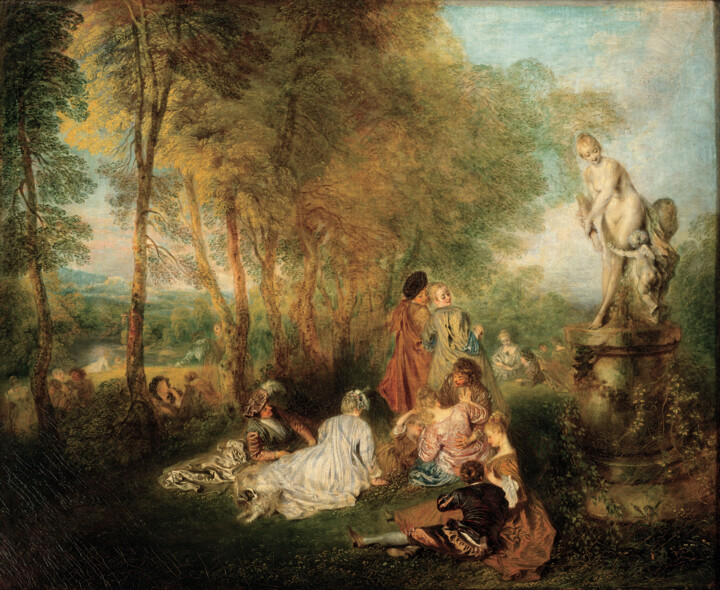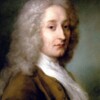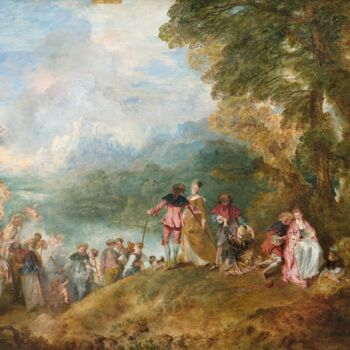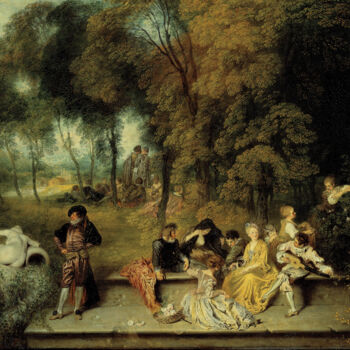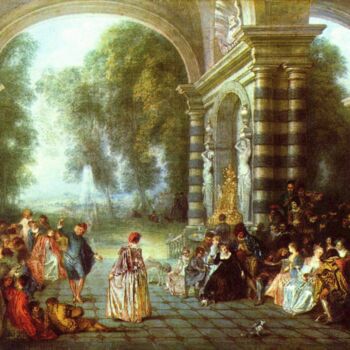La fête de l'amour (1719) 绘画 由 Antoine Watteau
Une statue de Cupidon, l'ancien dieu de l'amour, domine une partie de la composition, renforçant le thème amoureux de la scène et servant d'ancrage visuel dans le tableau. Son inclusion suggère peut-être l'influence de l'amour et du désir qui plane sur les invités.
La lumière joue un rôle essentiel dans cette œuvre, avec des éclats lumineux qui filtrent à travers les feuilles, créant un effet de lumière et d'ombre qui anime la composition et accentue la texture des vêtements et de la verdure.
相关主题
Watteau's life is not well known, but his art is very important ( baptised October 10, 1684 – died July 18, 1721). At the beginning of the 18th century, he set new standards for French painting. One can talk about how he was born into a poor family in a small town in Flanders, which was then ruled by the French. He got his first training from a little-known local painter and moved to Paris around 1702. There, Claude Gillot and Claude III Audran, two of his teachers, helped him develop his skills in different ways. Through Gillot, he learned how the theater could help him visualize things and how this could lead to the idea of an ambiguous reality. He learned the art of the arabesque from Audran. The arabesque's mix of ornamental and figural shapes had a big impact on his own style. As Concierge of the Palais du Luxembourg, Audran gave Watteau access to Rubens's Medici Gallery. This was important because it helped Watteau study the Flemish painter and other old masters in the years to come. Watteau's career spanned the last years of Louis XIV's rule and the start of the Regency. These were times when the rules set by the court and the Academy were becoming less strict and when changes in society made it possible for new ideas about art to emerge. Watteau created a new style of painting called "Fête galante" because of this, and the Academy's increasing openness helped him do it. In 1717, he was finally accepted into the Academy (second Rome Prize 1709, admission as a candidate 1712). He was a very sensitive and weak man, both mentally and physically. He confused his peers and helped define the modern artist as an outsider and an innovator. Watteau spent his last years with friends like the painter N. Vleughels and the art dealer Gersaint, for whom he made the now-famous shop sign (Charlottenburg Palace) in 1720. He avoided the public and moved around a lot during those years. Watteau went to London in 1719 and 1720 to try to get better from a serious illness (possibly tuberculosis). There, he met Dr. Mead, who helped his art become very popular in England right away. Almost all of the important biographies of Watteau (by Jean de Jullienne in 1726, Gersaint in 1744, Dezallier d'Argenville in 1745, and Comte de Calus in 1748) talk about how unique and good his drawings are. Watteau's favorite medium was either red chalk or a mix of red, black, and white chalk, which some colorists at the Academy, like La Fosse and Coypel, were already using at the end of the 17th century.

